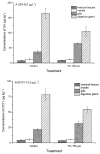Effect of Suspended Particulate Matter on the Accumulation of Dissolved Diarrhetic Shellfish Toxins by Mussels (Mytilus galloprovincialis) under Laboratory Conditions
- PMID: 29970810
- PMCID: PMC6071173
- DOI: 10.3390/toxins10070273
Effect of Suspended Particulate Matter on the Accumulation of Dissolved Diarrhetic Shellfish Toxins by Mussels (Mytilus galloprovincialis) under Laboratory Conditions
Abstract
In recent years, detection of trace amounts of dissolved lipophilic phycotoxins in coastal waters has been possible using solid phase adsorption toxin tracking (SPATT) samplers. To explore the contribution of dissolved diarrhetic shellfish toxins (DST) to the accumulation of toxins by cultivated bivalves, mussels (Mytilus galloprovincialis) were exposed to different concentrations of purified okadaic acid (OA) and dinophysistoxin-1 (DTX1) in filtered (0.45 µm) seawater for 96 h. Accumulation and esterification of DST by mussels under different experimental conditions, including with and without the addition of the food microalga Isochrysis galbana, and with the addition of different size-fractions of suspended particulate matter (SPM) (<75 µm, 75⁻150 µm, 150⁻250 µm) were compared. Results showed that mussels accumulated similar amounts of OA and DTX1 from seawater with or without food microalgae present, and slightly lower amounts when SPM particles were added. Mussels preferentially accumulated OA over DTX1 in all treatments. The efficiency of the mussel’s accumulation of OA and DTX1 from seawater spiked with low concentrations of toxins was higher than that in seawater with high toxin levels. A large proportion of OA (86⁻94%) and DTX1 (65⁻82%) was esterified to DTX3 by mussels in all treatments. The proportion of I. galbana cells cleared by mussels was markedly inhibited by dissolved OA and DTX1 (OA 9.2 µg L−1, DTX1 13.2 µg L−1) in seawater. Distribution of total OA and DTX1 accumulated in the mussel tissues ranked in all treatments as follows: digestive gland > gills > mantle > residual tissues. However, the percentage of total DST in the digestive gland of mussels in filtered seawater (67%) was higher than with the addition of SPM particles (75⁻150 µm) (51%), whereas the gills showed the opposite trend in filtered seawater with (27%) and without (14.4%) SPM particles. Results presented here will improve our understanding of the mechanisms of DST accumulation by bivalves in marine aquaculture environments.
Keywords: DST accumulation; DST esterification; Mytilus galloprovincialis; diarrhetic shellfish toxins (DST); suspended particulate matter (SPM).
Conflict of interest statement
The authors declare no conflict of interest.
Figures






References
-
- Marr J.C., Jackson A.E., McLachlan J.L. Occurrence of Prorocentrum lima, a DSP toxin-producing species from the Atlantic coast of Canada. J. Appl. Phycol. 1992;4:17–24. doi: 10.1007/BF00003956. - DOI
-
- Morton S.L., Bomber J.W., Tindall P.M. Environmental effects on the production of okadaic acid from Prorocentrum hoffmannianum Faust I. temperature, light, and salinity. J. Exp. Mar. Biol. Ecol. 1994;178:67–77. doi: 10.1016/0022-0981(94)90225-9. - DOI
Publication types
MeSH terms
Substances
LinkOut - more resources
Full Text Sources
Other Literature Sources

